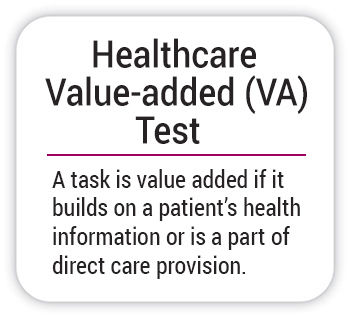The Healthcare Value-Added Test
efore we continue, can you recite the healthcare value-added (VA) test?

In America, hospitals are an 18th century concept. I stopped looking for the “first” hospital when Wikipedia handed me the Hotel-Dieu in Paris, a hospital founded in 651. That’s all I needed. The earliest hospitals predate anesthesia (1846), hand washing (1847), health insurance (1890-ish) and innumerable other innovations. Were any of them developed with the healthcare VA test in mind? Certainly not.
Verbatim recitation of the healthcare VA test isn’t important; defending the principle is.
If you’re having trouble, recall the 7 wastes and ask this fill-in-the-blank question:
"How does [insert process step here] benefit the patient?"
If your answer has any caveats, qualifiers, or stipulations, you might be cheating.
Please bear in mind that labeling each and every step as either NVA or VA can quickly become an academic exercise. It’s much more practical to keep an eye open for the most costly forms of NVA - defects, waiting, over-processing/over-production.
Have you ever wondered where the test came from? Perhaps it was chiseled into tablets atop Mt. Fuji by Taiichi Ohno and carried down the mountain by James Womack? No. It was developed here, the result of an examination of the WHY of healthcare. Why do patients step through our doors?
- Information about their health
- Care provision
There are precious moments when the system’s energies are focused on those points. Those are the VA moments for a patient. It’s not trivial that we refer to the “patient’s value-added test” using the singular possessive. To use the plural possessive, “patients’ value-added test,” would be to suggest it’s value-added to Jones for us to work on Smith’s case, but it’s not, even if Jones and Smith are besties.
Strictly speaking, everything that doesn’t directly address those two items above is NVA.
I’ll close with a grandiose rhetorical musing. I’m not going to do this every time and please don’t feel the need to reply to this part.
In 2008, before I worked for the U, a patient advocate pointed out to me that hospitals exist for the convenience of providers. It’s undeniably true. It’s also undeniable that providers would be able to serve far fewer patients if we insisted on house calls.
Is a hospital the building? Or is a hospital the talent and processes at work within? If you were to tear it all down and start again with the healthcare VA test applied to each decision, what would healthcare delivery look, sound, and feel like? Would you be able to shake off the preconceived notions of what it takes to run a healthcare system? Would hospitals be recognizable?
---
This post has been edited to remove my ill-formed example pointing out that specialized nursing units exist for the convenience of providers. It’s ill-formed because this provider convenience results in less time walking the hallways by specialist providers (doctors, nurses, etc.) which ultimately removes NVA from the patient’s value stream. -SJ
Steve Johnson
Value Improvement Leaders (VIL) is a 13 week leadership course offered at University of Utah Health that teaches the skills needed to provide sponsorship and leadership for value improvement work. Principles taught are taken from Lean, Six Sigma, and PDSA methodologies. The course explains theory, provides healthcare examples of many specific leadership techniques, and uses an applied learning model. Not everyone can take the course, but everyone can follow along with the lesson plan.
The 8th waste is underutilization of employee talent. In this week's post of Steve's Dojo (or continuing Lean Six Sigma education), Steve revisits Taiichi Ohno’s "7 wastes" and answers why he doesn't teach the "8th waste" at University of Utah.
Complete archive of the lean six sigma training series: Steve's Dojo.
